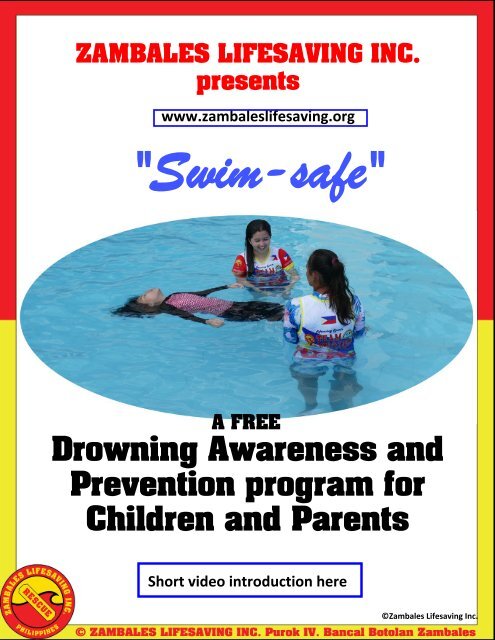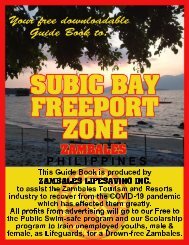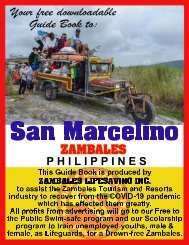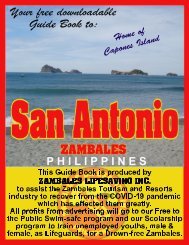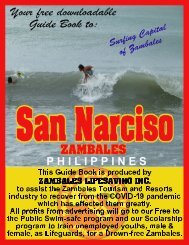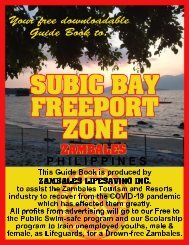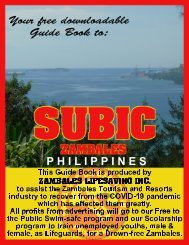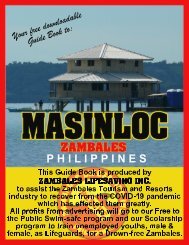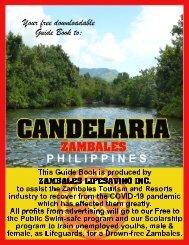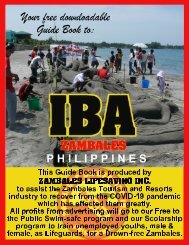Swim-safe
Drowning Awareness and Prevention program of Zambales Lifesaving Inc. Philippines.
Drowning Awareness and Prevention program of Zambales Lifesaving Inc. Philippines.
You also want an ePaper? Increase the reach of your titles
YUMPU automatically turns print PDFs into web optimized ePapers that Google loves.
ZAMBALES LIFESAVING INC.<br />
presents<br />
www.zambaleslifesaving.org<br />
"<strong>Swim</strong>-<strong>safe</strong>"<br />
A FREE<br />
Drowning Awareness and<br />
Prevention program for<br />
Children and Parents<br />
Short video introduction here<br />
©Zambales Lifesaving Inc.
© ZAMBALES LIFESAVING INC. Purok IV. Bancal Botolan Zambales<br />
The <strong>Swim</strong>-<strong>safe</strong> program is<br />
not based on swimming<br />
lessons, it is based wholly<br />
on<br />
SURVIVAL TECHNIQUES.<br />
What you will learn here is<br />
how to recognize dangers<br />
and potential hazards, so<br />
as to minimize your risks<br />
and thus, increase the<br />
<strong>safe</strong>ty and well-being of<br />
your children.
One of the most important<br />
things you need to learn is:<br />
REACH OR<br />
THROW<br />
BUT NEVER GO!<br />
Only a trained and certified<br />
Lifeguard should attempt<br />
to conduct an "in water"<br />
rescue, as an untrained<br />
person can easily become<br />
another victim!
So act quickly and find<br />
anything that floats that<br />
you can throw to the<br />
person in difficulty so they<br />
can stay afloat, or reach to<br />
them with anything<br />
accessible that allows you<br />
to extend your reach such<br />
as a towel, beach umbrella,<br />
pool leaf skimmer,<br />
plastic bottle or rope etc.<br />
You can view a Video here
Beach hazards:<br />
RIP currents:<br />
Only occur when there are waves.<br />
Basically, the water piling up on<br />
the beach must return to the sea,<br />
so it creates gullies in the sand, or<br />
flows parallel along the beach to<br />
the end of the beach, reef or a<br />
headland, for it to flow back to the<br />
sea.<br />
If you understand them, they are<br />
not so dangerous. In fact, lifesavers<br />
and surfers generally use these as<br />
the fastest way out beyond the<br />
breaking waves.
Understanding RIP currents, as<br />
before, they only exist if there is<br />
wave action, no waves = no RIPs.<br />
The general behavior of RIPs is to<br />
return water to the sea, thus, if<br />
you are in one you may be swept<br />
out to sea. Three important factors<br />
to remember:<br />
1. RIP's do not pull you under the<br />
water.<br />
2. RIP's do not go far out to sea,<br />
generally they only go as far as<br />
to where the waves are breaking<br />
and not further.<br />
3. NEVER swim against the RIP as<br />
you may be swimming backwards<br />
and just tire yourself out.
If you get caught in a RIP, do the<br />
following:<br />
<strong>Swim</strong> parallel to the beach until<br />
you feel the effects of the RIP have<br />
stopped, then swim back to the<br />
beach, often at that point you can<br />
probe with your feet and find a<br />
sand bar to assist you.
Common signs of a<br />
RIP current:<br />
No breaking waves.<br />
Rippled appearance on the<br />
waters surface.<br />
Discolored water or debris<br />
flowing out beyond the waves.<br />
You can view videos here.
Inshore holes or gutters:<br />
These are another potentially<br />
dangerous hazard, generally found<br />
right at the shores edge. These are<br />
especially dangerous for small<br />
children and non swimmers, as<br />
you can find yourself going from<br />
shallow water to over your head in<br />
just one step.<br />
This occurs when you have surging<br />
waves breaking right on the shore<br />
line, these waves excavate the<br />
sands so the water can flow along<br />
the beach and then back to the<br />
sea.
You can find yourself going from this....<br />
in just one step, to this....<br />
Video available here.
Other dangers:<br />
Heat exhaustion and<br />
Heat stroke.<br />
Both of the above are caused by<br />
dehydration, being immersed in<br />
water makes you feel cool, but you<br />
are still loosing body fluids, so<br />
remember to drink plenty of fluids<br />
and avoid direct exposure to the<br />
sun where possible.<br />
Sunburn.<br />
Always remember to use sunscreen<br />
and avoid direct exposure to the<br />
sun where possible.
Marine Stingers:<br />
There are a large number of Jelly<br />
fish and other creatures that can<br />
sting. In most cases, wash with<br />
Vinegar for at least 5 minutes will<br />
remove the pain.<br />
For both Bluebottles (Portuguese<br />
Man o War) and<br />
penetration from<br />
fish spines or Sea<br />
Urchins, soak in<br />
hot water (42°C)<br />
for at least 60<br />
minutes.<br />
Cone Shells.<br />
All cone shaped<br />
shells can sting,<br />
some in fact, can<br />
even be fatal.
Rivers and Creeks:<br />
have a number of hazards that you<br />
need to be aware of, such as:<br />
Submerged branches and snags.<br />
Uneven and stony bottoms.<br />
Currents, especially in rainy season.<br />
REMEMBER: Never dive or rope<br />
swing into areas that you have not<br />
confirmed are deep enough and<br />
free of snags or obstructions.<br />
If the water is dirty, be very careful<br />
in exploring the area for <strong>safe</strong>ty.
Waterfalls:<br />
Can be exceptionally dangerous,<br />
be extra careful if you plan to<br />
climb, as the rocks can be very<br />
slippery.<br />
Never jump or dive off the<br />
waterfall without first checking<br />
that the water is deep enough to<br />
do so <strong>safe</strong>ly.<br />
Waterfalls can also create an<br />
"undertow" that can trap you at<br />
the bottom, see below to escape.
SWIMMING POOLS<br />
and other closed water<br />
environments, such as rivers,<br />
creeks and lakes.<br />
REACH or THROW<br />
is a must in all of these places.<br />
Link to video here.<br />
DANGERS AROUND<br />
THE HOME:<br />
Did you know that hundreds of<br />
children actually drown in their<br />
homes every year.<br />
Do you have any idea why?
Yes.... the common pail or dish<br />
for washing clothes, left with<br />
water and unattended, these are<br />
a death trap for young children,<br />
especially toddlers, many do not<br />
realize, but it only takes as little<br />
as 20 mm of water to drown.
So always be sure to either empty<br />
the container and store it either<br />
on it's side, or upside down, so as<br />
it cannot hold water, or<br />
alternatively cover it with a sealed<br />
child proof cover.<br />
Supervising children<br />
It is very common for a parent or<br />
adult to supervise children when<br />
they are enjoying a splash in the<br />
pool or at the beach, however<br />
statistics are showing a large<br />
increase in the number of children<br />
who drown whilst under the<br />
supervision of an adult, from 45% a<br />
decade ago to 86% today. WHY?
Yes DISTRACTIONS<br />
Due to the growing number of<br />
smart phones, gadgets and laptop<br />
computers, many who should be<br />
supervising are far too distracted to<br />
do so, so if you are the one to<br />
supervise, leave your phone, gadget<br />
or laptop in your bag, or better still<br />
in the car or at home.
Another common problem is that<br />
many people do not understand<br />
that drowning, more often than<br />
not, is silent. This is because in<br />
most cases the child is so scared or<br />
has ingested large quantities of<br />
water that they are unable to shout<br />
for help.<br />
In many cases, those supervising<br />
think the child is splashing and<br />
playing, when in fact they are in<br />
dire difficulties.<br />
So it is important to be able to<br />
recognize the signs of drowning, as<br />
it is only a matter of 4 minutes or<br />
less till irreversible brain damage.
Early warning signs<br />
Vigorous exertion<br />
High 02 Consumption<br />
Head above water<br />
Flailing arms<br />
Shouting<br />
Shivering<br />
Crying
Secondary Warning stage<br />
Low exertion<br />
Sporadic breathing<br />
Water ingestion<br />
Head submersion<br />
Increased C02 build up<br />
Minimal arm movement<br />
4 – 6 min. 02 reserve<br />
No help request
Final stage<br />
No movement<br />
No signs of life<br />
From this point there is less than<br />
4 minutes until irreversible brain<br />
damage occurs.
Do not rely on others, even trained<br />
Lifeguards and Lifesavers, to watch<br />
your children, they are not there to<br />
be babysitters, nobody knows your<br />
children better than you, so realize<br />
your responsibility and concentrate<br />
on your children, not your phone or<br />
gadget.<br />
SECONDARY DROWNING:<br />
is something that most people<br />
have never heard of and are totally<br />
unaware of, but does occur in 1%<br />
to 2% of non-fatal drownings, in<br />
the Philippines that relates to<br />
between 3,000 and 4,000<br />
unnecessary deaths each year.
Secondary drowning is caused by<br />
aspirating a small amount of<br />
water into the lungs and can occur<br />
many hours after the incident,<br />
some medical specialists say this<br />
can occur up to 72 hours later.<br />
So if your child has had a situation<br />
where they may have ingested<br />
water you need to keep a close<br />
eye on them.<br />
Symptoms include:<br />
Coughing, Irritability, Lack of alertness and<br />
are easily exhausted,<br />
If your child shows any of these signs, seek<br />
medical care immediately!<br />
Do not lay your child down as that may<br />
accelerate the condition.<br />
Video available here.
Zambales Lifesaving Inc.<br />
run this program FREE to the<br />
public every year for 7 to 12 year<br />
olds, along with a Parent or<br />
Guardian, as it is as important to<br />
teach the adults as to what<br />
dangers exist and how to deal<br />
with them, as it is the children.<br />
During the actual program, our<br />
instructors also introduce the<br />
participants to actual scenarios in<br />
the pool and teach the children<br />
how to "FLOAT", because if you<br />
can float you can survive, as they<br />
will not panic, thus can call and<br />
wait for assistance.<br />
Video available here
We wish to thank the following who<br />
support this program every year.<br />
For Northern and Central Zambales.<br />
For Southern Zambales and the<br />
Subic Bay Freeport Zone.<br />
Dr. Johan Ong.<br />
and the continued support of<br />
Check our Social Media Page for upcoming programs
We wish to thank the following for materials<br />
and videos used in this presentation.<br />
ABC - 22 News<br />
Australian Lifesaving Academy New South Wales<br />
Pro Trainings<br />
Royal Life Saving Society Australia<br />
Surf Life Saving Australia<br />
Surf Life Saving Far North Coast<br />
University of New South Wales<br />
For all your insurance needs, Household - Business - Vehicular - Marine and others.<br />
Standard Insurance Co., Inc. is committed to continuously improve the quality of<br />
service to the insuring public through fairness, professionalism, innovation, and<br />
simplicity.<br />
Call 0917 821 2366 for information or visit their Facebook page for the Olongapo<br />
Branch
If you are interested on<br />
information for dates<br />
and venues of our future<br />
<strong>Swim</strong>-<strong>safe</strong><br />
programs<br />
Open and "Like" our<br />
Facebook page which<br />
always carries updates


